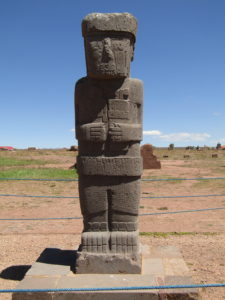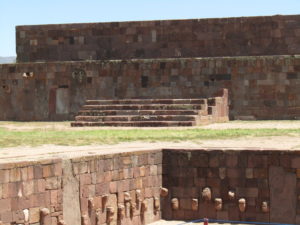By Elisabeth Warner
 It was impressive to see the ruins of the civilization of Tiwanaku. The structures were surprisingly advanced and intricate, and took a long time to complete. The people were able to carve in perfect symmetry and with 90 degree angles. The stones of the buildings were carved so exactly to one another that there were no gaps between them. The modern reconstruction of some of the walls was less perfectly carved than the original stones. Even some carved indentations in the stone were perfectly square: the sides and bottoms were at all 90 degree angles. Some of the carvings were practical, but most were for religious reasons. My favorite part was that many Aymara people still practice the ancient ceremonies that the people of Tiwanaku did. This was, and still is, a sacred place to them. This made me feel more connected to the indigenous peoples of Bolivia. Seeing their history, the roots of their religion, helped me to better understand them. They had carvings of faces, and not all of them are what we consider to be Bolivian today. Represented among the carvings were faces of African and Asian origin, telling of the diversity of Bolivia even back then. We toured ruins of three temples: upper, middle, and buried. They are representative of the three worlds: the upper world (heaven), the middle ground (the world we live in), and the underground. Everything circled back to their beliefs. Even the shape of the pyramid (upper temple) was representative of their Andean cross. We had an Aymaran tour guide, and hearing him talk about his connection to the temple today is something difficult to put into words.
It was impressive to see the ruins of the civilization of Tiwanaku. The structures were surprisingly advanced and intricate, and took a long time to complete. The people were able to carve in perfect symmetry and with 90 degree angles. The stones of the buildings were carved so exactly to one another that there were no gaps between them. The modern reconstruction of some of the walls was less perfectly carved than the original stones. Even some carved indentations in the stone were perfectly square: the sides and bottoms were at all 90 degree angles. Some of the carvings were practical, but most were for religious reasons. My favorite part was that many Aymara people still practice the ancient ceremonies that the people of Tiwanaku did. This was, and still is, a sacred place to them. This made me feel more connected to the indigenous peoples of Bolivia. Seeing their history, the roots of their religion, helped me to better understand them. They had carvings of faces, and not all of them are what we consider to be Bolivian today. Represented among the carvings were faces of African and Asian origin, telling of the diversity of Bolivia even back then. We toured ruins of three temples: upper, middle, and buried. They are representative of the three worlds: the upper world (heaven), the middle ground (the world we live in), and the underground. Everything circled back to their beliefs. Even the shape of the pyramid (upper temple) was representative of their Andean cross. We had an Aymaran tour guide, and hearing him talk about his connection to the temple today is something difficult to put into words.  He was able to bring us even closer to the culture of Tiwanaku through his explanations of his culture, his beliefs. The religious ceremonies practiced in Tiwanaku are ones he still celebrates to this day. The temple of Tiwanaku even has a reconstructed altar that they use nowadays for ceremonies. The largest ones are at the equinoxes and solstices. Overall, I was impressed with the dedication of the people of Tiwanaku to their religion. The magnitude of the temples and carvings are a testament to depth of their faith.
He was able to bring us even closer to the culture of Tiwanaku through his explanations of his culture, his beliefs. The religious ceremonies practiced in Tiwanaku are ones he still celebrates to this day. The temple of Tiwanaku even has a reconstructed altar that they use nowadays for ceremonies. The largest ones are at the equinoxes and solstices. Overall, I was impressed with the dedication of the people of Tiwanaku to their religion. The magnitude of the temples and carvings are a testament to depth of their faith.